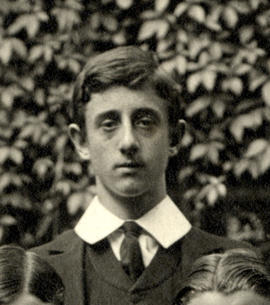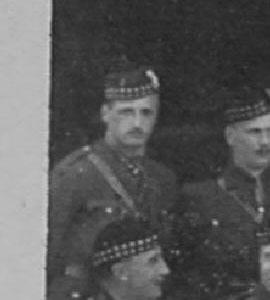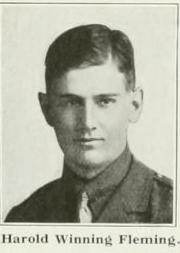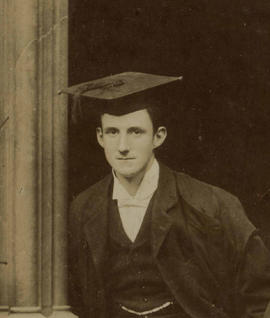Frith, Herbert Philip, only son of Edward Philip Frith, of Notting Hill, and grandson of William Powell Frith, R. A., C. V. O.; b. Jan. 21, 1890; adm. May 4, 1905 (A); left Easter 1907; Asst. District Officer at Lokoya, Nigeria, West Africa; was attached to the West African Frontier Force on the outbreak of Great War I; d. Nov. 16, 1914, from wounds received in action at Lokoya.
Forster, Ralph Louis Francis, son of Ralph George Elliott Forster (q.v.); b. July 13, 1898; adm. Sept. 26, 1912 (G); left Dec. 1915; 2nd Lieut. 1st Batt. the Buffa (East Kent Regt.) Aug. 16, 1916; went out to the western front in the autumn of 1916; killed in action at Monchy May 3, 1917; unm.
Forbes, Peter Fraser Lestock, son of Sidney Lestock Forbes of Putney; b. 20 Mar. 1918; adm. May 1932 (G); left Dec. 1934; 2nd Lieut. Rajputana Rifles IA 1942; d. of wounds in Burma Feb. 1943.
Peter Fraser Lestock Forbes was born at Bournemouth, Hampshire on the 20th of March 1918 the younger son of Sidney Lestock Forbes, an engineer, and Edith Lizzie (nee Goodwin) Forbes of Putney, later of “Beggars Roost”, Seven Hills Road, Cobham in Surrey. He was educated at Westminster School where he was up Grant’s from May 1932 to December 1934. He won the Pancake Greaze in 1933.
He enlisted in the army where he rose to the rank of Lance Corporal before being commissioned as a 2nd Lieutenant in the Indian Army on the 28th of May 1942.
His funeral took place on the 27th of February 1943.
He is buried at Kirkee War Cemetery Plot 8, Row K, Grave 15.
Forbes, Alexander Stewart, son of Patrick Lewis Forbes, of Hampstead, by Sara Mildred Leckie, of Blackheath, Kent; b. March 29, 1894; adm. Jan. 14, 1909 (H); left July 1913; entered a firm of Anglo-Russian cotton manufacturers, and was in Russia at the outbreak of Great War I; returned heme in Oct. 1914; 2nd Lieut. wth (Reserve) Batt. the Seaforth Highlanders Nov. 9, 1914; Lieut. Oct. 7, 1915; attached to the 181st Machine Gun Co., and went out to the western front in June 1916; d. Aug. 17, 1916, of wounds received in action near Albert on the previous day.
Flockhart, William Whyte Stuart, son of William Flockhart, of St. Marylebone, architect; b. June 24, 1886; adm. May 3, 1900 (H); left Dec. 1903; Cpl. 14th (Co. of London) Batt. the London Regt. (London Scottish); served on the western front; killed in action at Messines Nov. 1, 1914.
Fleming, Harold Winning, second son of Alexander John Fleming, M. D., of Hampstead, by Lily Huthart; daughter of Forrest L. Brown, of Bombay, India; b. April 25, 1898; adm. as non-resident K.S. Sept. 28, 1911 (H); left July 1915; went abroad on account of his health; R.M.C. Sandhurst Aug. 28, 1916 - May 1, 1917; 2nd Lieut. 1st Batt. Beds Regt. May 11, 1917; went out to the western front May 31, 1917; mentioned in despatches L. G. 1917; killed in action at Gheluvelt, Belgium, Oct. 5, 1917; unm.
Fisher, John Malcolm, elder son of the Rev. William Fisher, of Norwood, by Anna Maria Isabella, daughter of John Edward Hunt, of Douglas, Isle of Man; b. June 7, 1890; adm. Sept. 24, 1903 (H); left July 1908; 2nd Lieut. 5th Batt. York and Lancaster Regt. Aug. 14, 1914; temp. Lieut. April 1915; Capt. June 1, 1916; served on the western front April 13, 1915; - Nov. 11, 1918, on the staff Feb. 1, 1917 - Nov. 11, 1918; mentioned in despatches L. G. March 15, 1916; Dec. 11, 1917 and July 5, 1919; M.C. March 15, 1916; D.S.O. June 3, 1919; Major Feb. 16, 1928; Lieut.-Col. Feb. 16, 1933; T. D.; Brevet Col. Feb. 16, 1937; (Middle East) L. G. Dec. 15, 1942 and June 24, 1943; m. Nov. 13, 1919, Alice, youngest daughter of Sir William James Bell, D. L., of Godstone, Surrey; d. on active service in North Africa, May 18, 1943.
John Malcolm Fisher was born at Leeds, Yorkshire on the 7th of June 1890 the elder son of the Reverend William Fisher and Anna Maria Isabella (nee Hunt) Fisher of 24, Lunham Road, Norwood in Surrey, later of Kingham Rectory, Oxford. He was educated at Westminster School where he was up Homeboarders from the 24th of September 1903 to July 1908.
Following the outbreak of the Great War he was commissioned as a 2nd Lieutenant in the 5th Battalion, York and Lancaster Regiment on the 14th of August 1914 and he joined them at their base at Rotherham. The Battalion was designated as the 1/5th Battalion and on the 13th of April 1915 they left York in two trains bound for Folkestone where they embarked later in the day and arrived at Boulogne at 11.30pm that night. They disembarked at 5am the following morning. He was promoted to Lieutenant on the 9th of October 1915.
At 5.25am on the 19th of December 1915 the Battalion was in trenches near the canal bank at Ypres when the Germans began shelling their positions with heavy artillery fire. This lasted until 9am and continued intermittently throughout the day. Gas was released on the Battalion’s positions but no enemy infantry attack followed. Those of the enemy who showed themselves were shot by the Battalion snipers. Although the trenches only suffered minor damage from the shelling, three officers and six other ranks were killed by the gas with a further four officers and eighty seven other ranks suffering from the effects of it. Five other ranks were killed by bullets and shell fire with one officer and twenty three other ranks wounded. That night they were relieved by the 1/7th Battalion, The Duke of Wellington’s Regiment (West Riding) and they marched to a rest camp.
For his actions that day John Fisher was one of three officers from the Battalion to be awarded the Military Cross, which was announced by the War Office on the 15th of March 1916. The citation for his award read: - “For conspicuous good service. During an enemy attack, when his senior Officer was incapacitated, he assumed command of his battalion, organised the ammunition supply, arranged for the relief for the night, sent in clear reports to Headquarters, and carried on generally in a manner to inspire confidence.”
He was promoted to temporary Captain on the 1st of June 1916 and to Captain on the 26th of June 1917, with precedence from the 1st of June 1916. He was appointed as a General Staff Officer 2nd Grade in early 1918 and served on the Staff of 49th Division.
He was Mentioned in Despatches on three occasions, which were announced in the London Gazette of the 15th of March 1916, the 11th of December 1917 and of the 5th of July 1919. He was awarded the Distinguished Service Order in the King’s Birthday Honours List of the 3rd of June 1919. He applied for his medals on the 5th of January 1920.
He was married at All Souls Church, Marylebone on the 13th of November 1919 to Ailie (nee Bell) of Faygate, Sussex. Following the end of the war he remained in his old Battalion and was promoted to Major on the 16th of February 1928. He was promoted to Lieutenant Colonel on the 16th of February 1933 when he was appointed to the command of his Battalion. He was awarded the Efficiency Decoration of the Territorial Army in February 1934 for his services in training anti-aircraft personnel. He was promoted to Brevet Colonel on the 16th of February 1937 and continued to the command his Battalion when it became the 67th (The York and Lancaster Regiment) Heavy Anti Aircraft Brigade, Royal Artillery. He was awarded the Order of the British Empire (Military Division) in the King’s Birthday Honours List, which was announced by St James’s Palace on the 9th of June 1938.
During the Second World War he was appointed to the command of the 13th Light Anti Aircraft Regiment and went with them to the Middle East in October 1940 where he saw action in Libya and at the siege of Tobruk. He served on the General Staff from April 1943 where he was involved in planning the defence of Egypt and was twice Mentioned in Despatches.
On the 18th of May 1943, John Fisher was at Tripoli and was entering his car when he died suddenly from heart failure.
He was created as a Commander of the British Empire, which was announced by St James’ Palace on the 14th of October 1943. The recommendation for the award read as follows: - “During the period under review Col. Fisher in addition to his normal A.A. defence duties which he has always carried out most efficiently, has had to organise the special precautions connected with the French Fleet. This for various reasons has required clear thinking, and decisions and untiring energy, all of which Col. Fisher has displayed. During the period of Eighth Army operating he maintained an efficient AA cover over Alexandria Harbour for which he received the thanks of and congratulations of RN.”
A friend wrote of him: - “We all knew him very well in Alexandria and were delighted when he came back the other day as our Brigadier. He will be greatly missed as he was not only our Brigade Commander but a warm friend to every one of us.”
He is buried at Tripoli War Cemetery Plot 6, Row G, Grave 12.
Fisher, Herbert Paul Greenwood, brother of John Greenwood Fisher (qv); b. 25 June 1908; adm. Sept. 1922 (A); left July 1926; dir. Benhams (Engineering) Ltd; PO RAFVR Apr. 1940; m. 5 Sept. 1931 Joyce Margaret Applin, d. of Frank Edwin Bennett of Streatham; killed in action over Libya 28 July 1940.
Herbert Paul Greenwood Fisher was born at Hampstead, London on the 25th of June 1908 the younger son of Herbert Fisher, an importer of clocks, and Josephine Hilda (nee Williamson) Fisher of 8, King’s Gardens Hampstead in London. He was christened at St James’ Church, West Hampstead on the 22nd of July 1908. He was educated at Westminster School where he was up Ashburnham from September 1922 to July 1926. On leaving school he became a director of Benhams (Engineering) Ltd and was later the Company Secretary to Dunbrik & Company Ltd, brick manufacturers.
He was married on the 5th of September 1931 to Margaret Joyce (nee Applin) and the couple lived at 115, Gaywood Road, King’s Lynn in Norfolk.
He enlisted in the Royal Air Force Volunteer Reserve where he trained as an observer and rose to the rank of Sergeant before being commissioned as a Pilot Officer on the 7th of April 1940.
On the 27th of July 1940, Herbert Greewood and his crew were one of eight aircraft from 30 Squadron which flew to from Iningi Maryut to Maaten Bagush where they were to operate under 202 Group in carrying out operations over the Libyan border.
Herbert Fisher and his crew took off from Maaten Bagush at 6.10am on the 28th of July 1940 in Blenheim Mk IF K7178 HY-B with one other aircraft from the Squadron to escort a Blenheim Mk IV aircraft from 113 Squadron which was undertaking a reconnaissance mission at 6.000 feet over the Italian lines at the border between Libya and Egypt. At 6.30am the other escort fighter entered cloud and became separated from Herbert Greenwood’s aircraft and from the Blenheim they were escorting. The two aircraft continued on their mission alone and were flying between Sollum and Bardia when they were intercepted by five Fiat CR42 fighters of 84 and 90 Squadriglia. During the ensuing combat their aircraft was shot down with the loss of the entire crew. The victory was shared by Sergente Scaglioni and Tenete Franco Lucchini of 90 Squadriglia. Franco Luchini’s aircraft had been so badly damaged by the return fire from the Blenheims that it tipped over on landing and was written off; he was killed in action on the 5th of July 1943. The Blenheim from 113 Squadron, although very badly damaged, managed to return to base alone.
The crew was: -
Flight Lieutenant Ian Cheesman Swann (Pilot)
Pilot Officer Herbert Paul Greenwood Fisher (Observer)
Sergeant John Young (Wireless Operator/Air Gunner)
The crew was buried close to the wreckage of their aircraft but their bodies were exhumed and mover to their present location in 1948.
He is buried at Knightsbridge War Cemetery Collective Grave 8D 8-9.
Fisher, Charles Dennis, sixth son of Herbert William Fisher, of Hove, Sussex, sometime Vice-Warden of the Stannaries of Cornwall and Devon, by Mary Louisa, second daughter of John Jackson, M. D., of Brighton, Sussex; nephew of Cecil Edward Fisher (q.v.); b. Aug. 4, 1877; adm. as Q.S. Jan. 15, 1891; elected head to Ch. Ch. Oxon. 1896, matric. October 1896; Slade Exhibitioner 1897; 1st class Classics (Mods.) 1908; 2nd class Lit. Hum. 1900; B.A. 1900; M.A. 1903; lecturer and tutor at Ch. Ch. 1901; official student 1903; censor 1907-14; played cricket for Oxford against Cambridge 1900, and for Sussex 1901; a Governor of the School from 1908; also a member of the Governing Body of Christ's Hospital School; being disabled from joining the army, Fisher, on the outbreak of war in Aug. 1914, learned to drive a motor, and enlisted in the R.A.M.C. Ambulance Corps; served in Flanders for a year and was mentioned in despatches for his bravery under fire; obtained a commission as Lieut. in the R. N. V. R. Aug. 16, 1915, and was appointed to H. M. S. Invincible; edited the text of Tacitus in the Oxford series of Scriptores Classici, and was engaged in writing a commentary of the Histories of Tacitus; drowned on board H. M. S. Invincible when it went down in the battle of Horn Reef, off Jutland, May 31, 1916; The Chivalry of the Sea was dedicated to his memory by the Poet Laureate; unm.
Fevez, Robin Lewis Gronow, brother of David Grunow Eugene Fevez (qv); b. 7 Nov. 1920; adm. Sept. 1934 (G); left Dec. 1937; King's Coll. Lond. 1938, enlisted Aug. 1939; The Queen's Regt, served Iraq 1942, Eighth Army 1943 (Capt.); killed in action (Italy) Sept. 1943.
Robin Louis Gronow Fevez was born at “Eversleigh”, Addlestone, Chertsey, Surrey on the 7th of November 1920 the younger son of Eugene Leon Fevez OW, a director of a wholesale textile company, and his second wife, Ethel Gronow (nee Oliver) Fevez of Radley Cottage, Church Road, Addlestone, Chertsey, later of 24, Woodville Road, Bexhill-on-Sea in Sussex. He was educated at St George’s College, Weybridge and at Westminster School where he was up Grant’s from September 1934 to December 1937. He went on to the Faculty of Science at King’s College, London University from 1938 to 1940 where he was a member of the London University Officer Training Corps. He had planned to become a research chemist but the outbreak of war intervened.
He enlisted as Private 6464127 in The Queen’s Royal Regiment (West Surrey) on the 25th of September 1939 and was posted to No. 162 Officer Cadet Training Unit on the 22nd of November 1940. He was commissioned as a 2nd Lieutenant in the Regiment on the 15th of March 1941. He was posted to the 2/5th Battalion of his Regiment and served in Iraq in 1942. He served as Acting Adjutant and as Battalion Itelligence Offier before being appointed to the command of D Company
On the 9th of September 1943, the 2/5th Battalion, The Queen’s Royal Regiment was in the leading wave of the Allied landings at Salerno for the invasion of Italy. The troops were loaded onto assault landing craft just after midnight and they headed for shore under a curtain of supporting fire from the naval guns offshore. The enemy returned fire and as the two leading landing craft approached the shore both were hit and damaged. Although there were a number of casualties in Robin Fevez’s boat, he was unhurt and landed on the beach shortly after 4am. The Battalion’s task was to land on the right of the 4,000 yard stretch of beach, to secure the beachhead and to advance a further 3,000 yards inland by first light. D Company, on the left of the Battalion’s attack, crossed bogs and ditches as they made their way inland where they secured their objective, a large agricultural college at Piccola a mile behind the beach. They had taken the position with few casualties and were in high spirits when a German tank was spotted some 300 yards to their front which heralded a counterattack by the 16th Panzer Division. C Company, which was the lead Company, suffered heavy losses but, with support from the other Companies the enemy attack was eventually driven off. At midnight on the 9th/10th of September the Battalion’s commanding officer received orders to resume the advance in order to attack before the Germans were able to reorganise.
A and D Companies began the advance in darkness with D Company moving up a road on the left. They moved forward for about an hour before they saw what looked in the gloom like an enemy tank in the middle of the road. A PIAT was ordered forward and knocked out what turned out to be an enemy self propelled gun and its half-track. A Platoon was then dispatched to investigate a nearby house on their right when the whole line came under heavy fire. Robin Fevez met Lieutenant Whitfield at a cross roads where the two men had to shout to hear each other due to the noise of the gunfire and of the tracer bullets whipping over their heads. He was ordered to dig in and to hold his position in preparation for an expected counterattack at first light. As daylight came it became clear that the Battalion was sited in the middle of an encampment of enemy tanks and the noise of their engines starting, coupled with heavy fire in all directions added to the confusion. Robin Fevez quickly realized that he and his men were about to find themselves in a desperate position with tanks attacking them from short range. He ordered his men to break out “as best as they could” but they were almost completely cut off from the rest of the Battalion. Only 20 men managed to get back to the Battalion with Robin Fevez being killed during the fighting withdrawal. The Battalion was relived the following day.
His brother, Pilot Officer David Gronow Eugene Fevez OW, 26 Squadron Royal Air Force was killed in action on the 5th of June 1940.
He is commemorated on the London University Roll of Honour
He is buried at Salerno War Cemetery Plot III, Row A, Grave 10.



